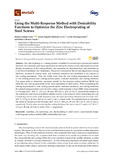Mostrar el registro sencillo del ítem
Using the multi-response method with desirability functions to optimize the zinc electroplating of steel screws
| dc.creator | Lostado Lorza, Rubén | es_ES |
| dc.creator | Martínez Calvo, María Ángeles | es_ES |
| dc.creator | Berlanga Labari, Carlos | es_ES |
| dc.creator | Rivero Fuente, Pedro J. | es_ES |
| dc.date.accessioned | 2019-07-01T09:27:40Z | |
| dc.date.available | 2019-07-01T09:27:40Z | |
| dc.date.issued | 2018 | |
| dc.identifier.issn | 2075-4701 | |
| dc.identifier.uri | https://hdl.handle.net/2454/33532 | |
| dc.description.abstract | Zinc electroplating is a coating process controlled by several input process parameters. However, the commonly used input parameters for setting the process of zinc deposition are current density, temperature of the coating solution, zinc concentration, deposition time, and concentration of additives (conditioner and brightener). The power consumed in the zinc plating process, coating thickness, increase in coating mass, and corrosion resistance are considered to be outputs or zinc coating parameters. They are widely used when the zinc coating requirements are based on the coating process cost, coating process speed, corrosion resistance, and coating thickness. This paper seeks to determine regression models by the response surface method (RSM) that relate the zinc coating parameters to the input parameters in steel screws. When considering the coating requirements of cost, coating process speed, corrosion resistance, and coating thickness, the optimal input parameters were found by using a multi-response surface (MRS). Input parameters of 0.3 amps/dm(2), 20.0 degrees C, 13.9 g/L, 45 min, 28.5 mL/L, and 2.8 mL/L, respectively (relative to the commonly used input parameters detailed above), were obtained when considering the cost. Considering minimization of the deposition time, the input parameters obtained were 0.5 amps/dm(2), 24.6 degrees C, 13.9 g/L, 45 min, 26.9 mL/L, and 1.1 mL/L, respectively. The optimal inputs to maximize the corrosion resistance were 0.6 amps/dm(2), 32.4 degrees C, 14.0 g/L, 45 min, 28.7 mL/L, and 2.5 mL/L, respectively. Finally, when maximizing the coating thickness, the inputs were 0.7 amps/dm(2), 38.4 degrees C, 12.2 g/L, 45 min, 26.5 mL/L, and 1.5 mL/L, respectively. | en |
| dc.description.sponsorship | The authors wish to thank the University of La Rioja for its support through Project ADER 2014-I-IDD-00162. | en |
| dc.format.extent | 20 p. | |
| dc.format.mimetype | application/pdf | en |
| dc.language.iso | eng | en |
| dc.publisher | MDPI | en |
| dc.relation.ispartof | Metals, 8 (9) | en |
| dc.rights | © 2018 by the authors. Licensee MDPI, Basel, Switzerland. This article is an open access article distributed under the terms and conditions of the Creative Commons Attribution (CC BY) license. | en |
| dc.rights.uri | http://creativecommons.org/licenses/by/4.0/ | |
| dc.subject | Modeling and optimizing zinc electroplating in steel screws | en |
| dc.subject | Experimental design | en |
| dc.subject | Multi-response surface method (MRS) | en |
| dc.subject | Desirability functions | en |
| dc.title | Using the multi-response method with desirability functions to optimize the zinc electroplating of steel screws | en |
| dc.type | info:eu-repo/semantics/article | en |
| dc.type | Artículo / Artikulua | es |
| dc.contributor.department | Institute for Advanced Materials and Mathematics - INAMAT2 | es_ES |
| dc.rights.accessRights | info:eu-repo/semantics/openAccess | en |
| dc.rights.accessRights | Acceso abierto / Sarbide irekia | es |
| dc.identifier.doi | 10.3390/met8090711 | |
| dc.relation.publisherversion | https://doi.org/10.3390/met8090711 | |
| dc.type.version | info:eu-repo/semantics/publishedVersion | en |
| dc.type.version | Versión publicada / Argitaratu den bertsioa | es |



